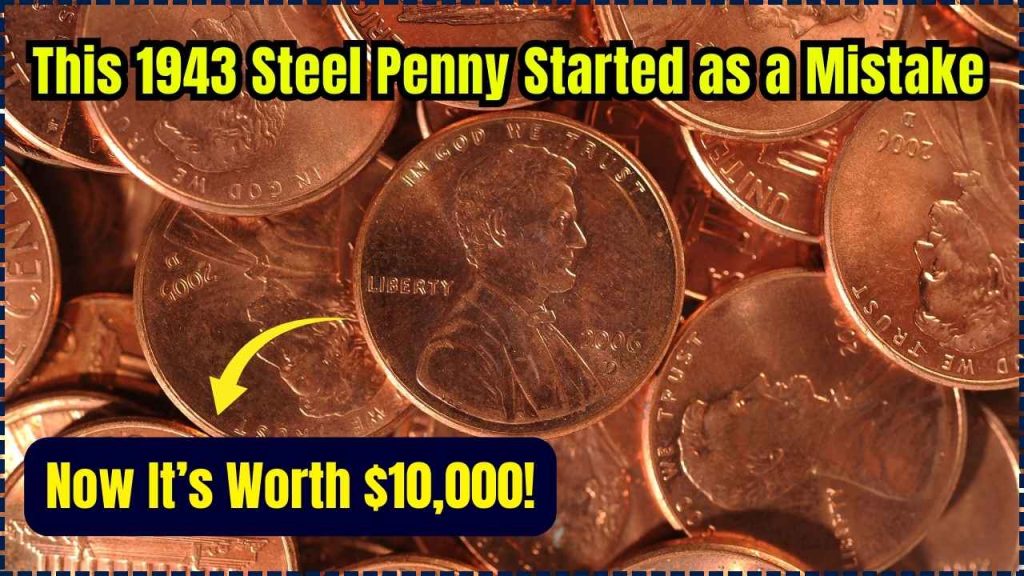1943 Steel Penny: The 1943 Steel Penny is a fascinating piece of American history that has captured the attention of both collectors and casual coin enthusiasts alike. What began as a wartime necessity quickly turned into one of the most talked-about coins in numismatic circles. While most 1943 steel cents are worth just a few cents, certain rare versions and error coins can fetch prices upwards of $10,000 or more.

This unassuming coin has stirred excitement at auctions, sparked curiosity in school coin collections, and even made headlines when rare versions surfaced in dusty jars or old wallets. Whether you’re a budding collector or a professional investor, understanding the history and value of the 1943 Steel Penny can be both rewarding and profitable.
1943 Steel Penny
| Topic | Details |
|---|---|
| Coin Name | 1943 Steel Penny |
| Material Used | Zinc-coated steel instead of copper |
| Reason for Change | Copper conserved for WWII ammunition and equipment |
| Common Value | 10 cents to $1 for most circulated coins |
| Rare Error Versions | 1943 copper penny, double die errors, off-center strikes |
| Top Sale Price | Up to $336,000 for 1943 copper penny |
| Steel Penny Worth | Up to $10,000+ for rare errors and pristine condition |
| Official U.S. Mint Site | www.usmint.gov |
The 1943 Steel Penny started out as a simple solution to a wartime copper shortage but became one of the most iconic and collectible coins in U.S. history. Its unique silver color, combined with the rare copper error versions and minting anomalies, make it a treasure hunter’s dream.
Whether you’re a 10-year-old going through your piggy bank or a seasoned collector tracking auction results, understanding the 1943 penny’s origins, variations, and market value is key to appreciating its legacy. Keep your eyes open—you might just have a valuable piece of history in your change jar.
Why Was the 1943 Steel Penny Made?
During World War II, copper was in high demand for military use. It was needed to make shell casings, telephone wires, and other essential war materials. The U.S. government prioritized wartime production, and every ounce of copper counted. As a result, the U.S. Mint was tasked with finding a suitable alternative metal for the one-cent coin, which had traditionally been made from 95% copper.
Instead of the usual copper alloy, the 1943 penny was made from steel coated with zinc. This gave the coin a shiny silver color, which confused some people at the time. Some even thought they had received a dime by mistake. The silver tone also made the coin susceptible to rust if the protective zinc coating wore off, which is common with circulated examples.
More than 1 billion steel cents were struck across three mint locations:
- Philadelphia Mint (no mint mark) – over 684 million coins
- Denver Mint (“D”) – over 217 million coins
- San Francisco Mint (“S”) – over 191 million coins
This makes the 1943 steel cent the only regular-issue U.S. coin ever minted for circulation in steel, making it a unique outlier in the history of American coinage.
Common vs. Rare: What’s Your 1943 Penny Worth?
If you have a regular 1943 steel penny, it may only be worth 10 to 50 cents in circulated condition. However, if the coin is in mint-state condition (uncirculated and shiny with no wear), it could be worth anywhere from $1 to $5, or even up to $30 depending on the grading scale.
But the excitement comes when we talk about error coins and rare varieties. These are the coins that make headlines.
1943 Copper Penny (Error Coin)
By mistake, some leftover copper planchets from 1942 were used in the presses, resulting in a few genuine 1943 copper pennies. These coins are ultra-rare, with only about 40 confirmed examples known to collectors today.
- In 2010, a teenager famously sold one for $1.7 million after finding it in his lunch money.
- In 2021, another fetched $336,000 at a major auction.
These pennies have become legendary among collectors. Just imagine finding one in a family heirloom box or coin jar!
Error Steel Pennies
Even among the legitimate steel issues, certain errors occurred during production, making these coins more valuable to collectors:
- Double Die Obverse (DDO): A manufacturing flaw where the die strikes the coin twice with slight misalignment, causing noticeable doubling of text or images.
- Off-Center Strike: Happens when the coin blank isn’t perfectly centered during minting, leaving part of the design missing.
- Repunched Mint Marks (RPM): These are mint marks that appear to have been stamped more than once, creating a shadow effect.
Depending on the rarity and visibility of the error, these coins can sell for anywhere from $100 to over $10,000.
How to Identify a Valuable 1943 Penny
Step 1: Check with a Magnet
Steel is magnetic. Copper is not. Place a household magnet over your 1943 penny. If it sticks, it’s steel. If it doesn’t, you might be holding a valuable copper version. To be sure, weigh the coin. A copper penny weighs around 3.11 grams, while a steel penny is about 2.7 grams.
Step 2: Look for Mint Marks
Beneath the date on the obverse (front) of the penny, you’ll find the mint mark:
- No mint mark = Philadelphia
- “D” = Denver
- “S” = San Francisco
Knowing the origin can help determine the coin’s rarity and possible value.
Step 3: Inspect for Errors
Get a good magnifying glass or jeweler’s loupe and check for:
- Doubling of letters or date
- Misaligned designs
- Raised bumps or die cracks
There are many reference books and online communities where you can compare your coin to verified error examples.
Step 4: Get it Graded
If your coin seems rare or in exceptional condition, submit it to a grading service like:
- PCGS
- NGC
A graded coin comes in a tamper-proof holder with certification, boosting both trust and resale value.
Tips for Collectors and Investors
Whether you’re a hobbyist or looking to invest in physical assets, here are some expert recommendations:
- Store coins in protective holders: Avoid PVC plastics, and use acid-free, archival-quality flips or holders.
- Never clean coins: Even a soft cloth can damage the surface. Collectors value originality.
- Document provenance: If you inherited coins or bought from a show, keep records. Provenance can impact resale.
- Stay informed: Follow numismatic news from CoinWeek or join collector groups on Reddit and Facebook.
Coin collecting isn’t just about profit—it’s also about the thrill of discovery and connecting with history.
Real-Life Example
In 2020, a 10-year-old in Massachusetts was going through his grandfather’s old coffee tin full of coins. He found a steel penny with a visible double die error. After some online research and a trip to a local coin dealer, the penny was confirmed and later appraised for over $4,000.
This story went viral on local news outlets and inspired many families to dig through their own coin jars. It’s a great reminder that valuable finds don’t always come from auctions—they can be hiding in your own home.
Are You Holding a $70 Million Fortune? These Rare Coins Could Be Hiding in Your Collection!
Top 10 State Quarters Breaking Records – Some Rare Coins Are Worth $10,500! Do You Own One?
Hidden Fortune: The $69M Bicentennial Quarter & 5 Other Million-Dollar Coins
Frequently Asked Questions About 1943 Steel Penny
Q1. How can I tell if I have a rare 1943 penny?
Use a magnet to check for steel. Look for copper-colored 1943 coins that don’t stick. Examine for errors and mint marks. Then get it appraised or graded.
Q2. Are all 1943 pennies valuable?
No. Most are common and only worth a few cents unless they have unique minting errors or are the rare copper variety.
Q3. What is the rarest version of the 1943 penny?
The 1943 copper penny is the rarest, with only about 40 known. These are worth hundreds of thousands to over a million dollars.
Q4. Where can I sell a rare 1943 penny?
Try certified dealers, major auction houses like Heritage Auctions, or platforms like eBay (use caution and get proper appraisals).
Q5. Is the 1943 Steel Penny still legal tender?
Yes, it’s still technically worth one cent—but no one would spend it, because it could be worth thousands to collectors.
Q6. How can I start collecting coins as a beginner?
Start small. Collect by year or type. Use coin folders, read guides, and attend local shows. It’s affordable and fun!











